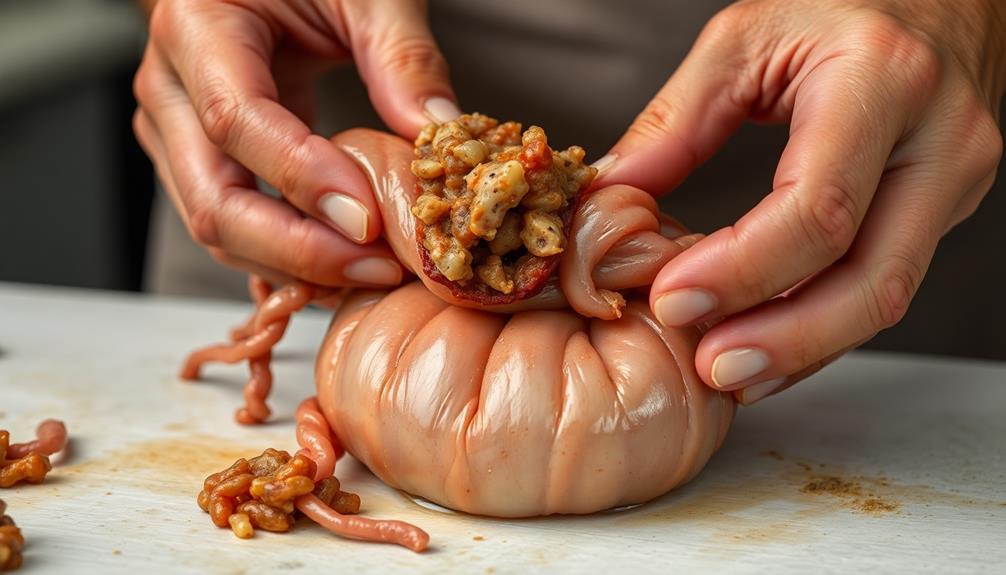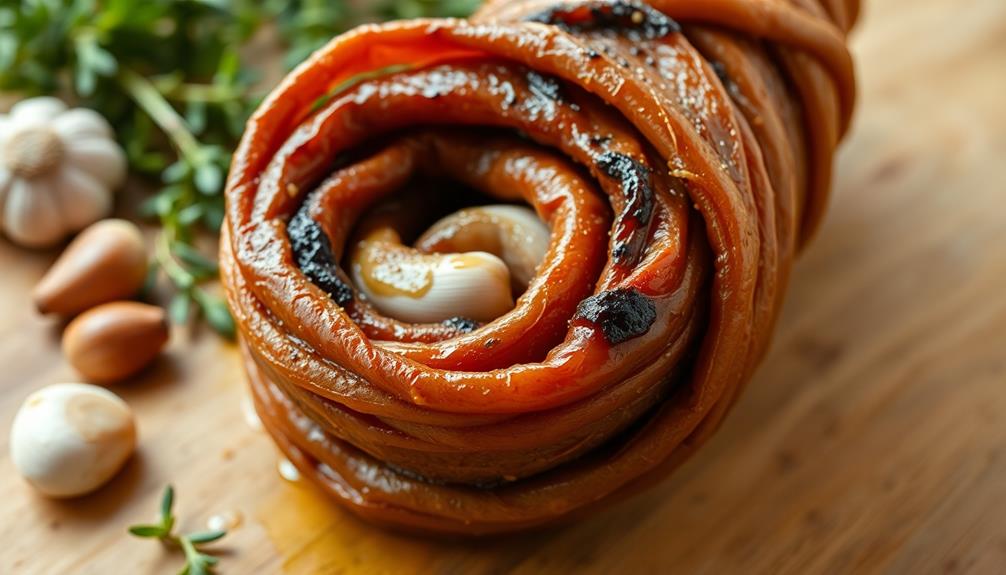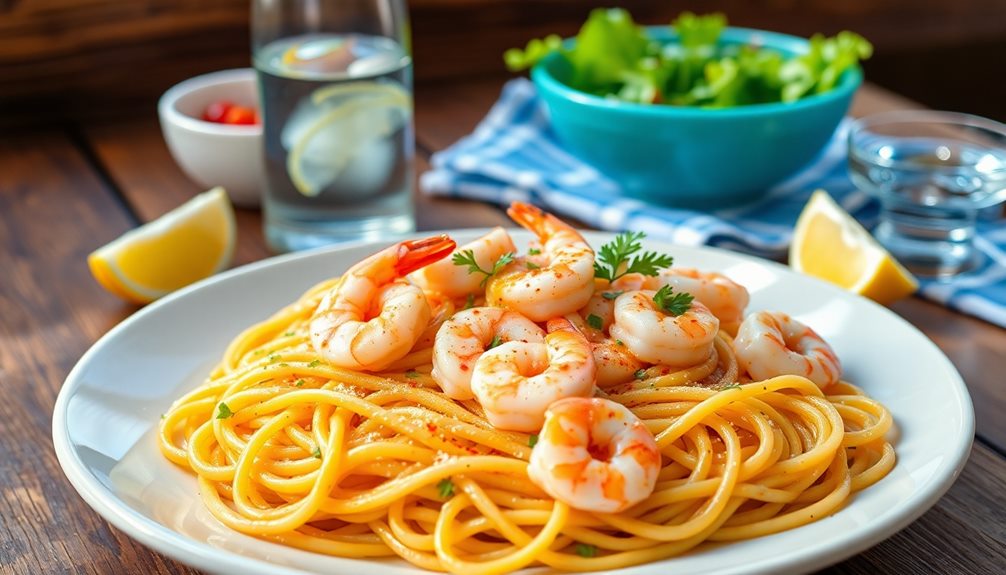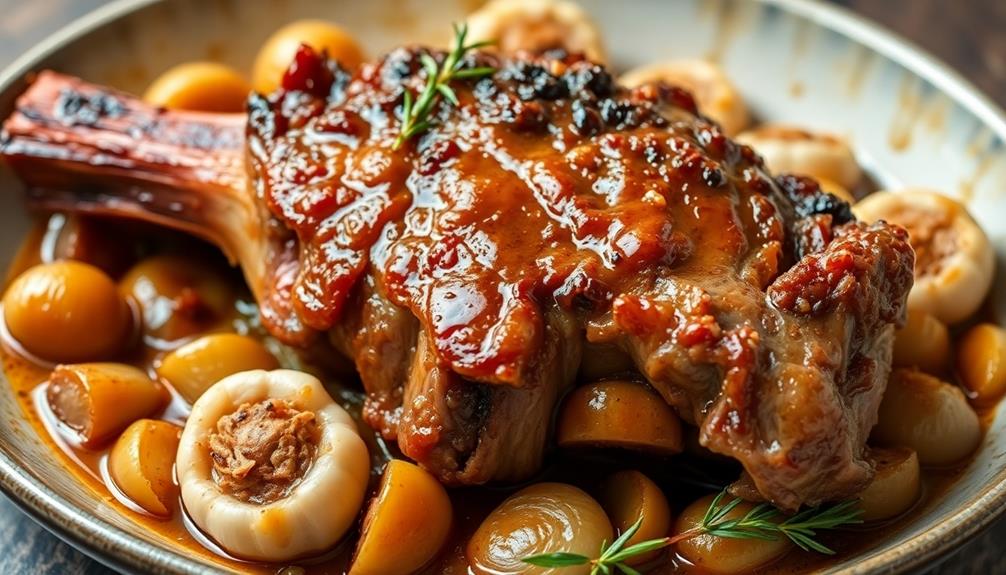Kokoretsi is the beloved Greek delicacy that's been delighting taste buds for centuries. This hearty dish features a mouthwatering blend of lamb offal and entrails, wrapped in the animal's own intestines. The preparation is a true labor of love, requiring meticulous cleaning, careful binding, and precise grilling to achieve the perfect crispy exterior and tender interior. The flavors are rich and complex, with aromatic herbs and spices complementing the natural goodness of the organ meats. Whether enjoyed during festive gatherings or savored on its own, this traditional Greek treasure is a testament to the resourcefulness and culinary artistry of rural communities. There's so much more to discover about this captivating dish.
Key Takeaways
- Kokoretsi is a traditional Greek dish made from lamb offal and intestines, reflecting the resourcefulness of rural farmers and shepherds.
- The dish holds deep cultural significance, often served during festive occasions and family gatherings, and is passed down through generations.
- Preparation of Kokoretsi requires skilled techniques, such as cleansing the offal, binding the ingredients, and closely monitoring the cooking process.
- The dish features a unique flavor profile, combining the rich, complex tastes of the organ meats with traditional Greek seasonings, and a contrasting crispy-tender texture.
- Serving Kokoretsi emphasizes its authentic, rustic qualities, often accompanied by fresh lemon and complementary dishes to balance the richness of the dish.
History
Kokoretsi has a rich history that dates back centuries. This beloved Greek dish has been a cornerstone of Mediterranean cuisine for generations, passed down through families with pride and reverence.
The origins of kokoretsi can be traced to the rural villages of Greece, where resourceful farmers and shepherds found creative ways to utilize every part of the lamb, leaving nothing to waste. The unique blend of offal, herbs, and spices was carefully wrapped in the lamb's intestines, creating a savory and textural delicacy that became a symbol of Greek culinary tradition.
Over time, the preparation of kokoretsi evolved, with each region developing its own distinct variations, reflecting the local flavors and preferences. From the herb-infused versions of the Peloponnese to the garlic-forward renditions of the Aegean islands, kokoretsi has remained a cherished part of Greek culture, transcending its humble beginnings to become a beloved national dish.
Today, the rich history of kokoretsi continues to inspire chefs and home cooks alike, preserving a culinary legacy that celebrates the ingenuity and resourcefulness of Greek culinary heritage.
Recipe
Kokoretsi is a traditional Greek dish made with lamb offal and entrails wrapped in lamb intestines. It's a hearty and flavorful dish that's often enjoyed during celebrations and gatherings. Kokoretsi is typically seasoned with a mixture of herbs and spices before being grilled to perfection. The result is a savory and succulent dish that is beloved by many in Greece. Additionally, it pairs well with other traditional Greek dishes, such as souvlaki and tzatziki. For a complete Greek culinary experience, be sure to try out this delicious recipe for koulouri bread rings.
The preparation of Kokoretsi requires skill and patience, as the process of cleaning and preparing the offal and intestines can be time-consuming. However, the end result is a delicious and unique dish that's worth the effort.
Ingredients:
- 1 kg lamb offal (liver, heart, kidneys, etc.)
- 1 kg lamb intestines
- 1 onion, finely chopped
- 2 cloves of garlic, minced
- 1 tablespoon dried oregano
- Salt and pepper to taste
- Olive oil for cooking
Cooking Instructions:
Thoroughly clean the lamb offal and intestines, removing any excess fat or membrane. Cut the offal into bite-sized pieces and mix with the onion, garlic, and oregano. Season with salt and pepper.
Carefully stuff the mixture into the cleaned lamb intestines, tying off the ends to create a sausage-like shape.
Extra Tips:
It is important to ensure that the lamb offal and intestines are thoroughly cleaned and prepared before cooking. This will help to prevent any unpleasant flavors or textures in the final dish.
Additionally, the kokoretsi can be grilled, roasted, or boiled, depending on personal preference and the desired texture.
Cooking Steps
First, you'll want to soak the offal in salted water to cleanse and tenderize it.
Next, bind the offal pieces together using the intestines as a wrapper.
Then, skewer the wrapped bundle so it's ready for grilling.
Step 1. Soak Offal in Salted Water

After procuring the offal, the next step is to soak it in salted water. This simple preparation helps to remove any impurities and tenderize the meat.
Start by filling a large bowl or pot with cool water and adding a generous pinch of salt. Gently place the offal pieces into the salted water, ensuring they're fully submerged. Allow the offal to soak for about 30 minutes, swishing it around occasionally to distribute the salt.
This process will help to draw out any blood or residual flavors you don't want in the final dish. Once the soaking is complete, drain the offal and pat it dry with paper towels.
The offal is now ready for the next step in preparing your delicious kokoretsi. Remember, taking the time to properly prepare the ingredients will ensure your final dish is as flavorful and tender as possible.
Step 2. Bind Offal With Intestines

With the offal cleaned and dried, you can now begin assembling the kokoretsi.
Take the intestines and gently stretch them out, removing any excess fat or connective tissue. Carefully thread the cleaned offal pieces through the intestines, arranging them in an even line. As you go, tie the intestines tightly between each piece to secure the filling.
Work slowly and methodically, ensuring the kokoretsi holds its shape. Once all the offal is wrapped, tie the ends of the intestines together to create a circular or spiral shape.
This intricate wrapping not only enhances the presentation but also helps the flavors meld together during cooking. With your kokoretsi neatly bound, you're ready to move on to the next step – cooking the delicate package to perfection.
Remember to handle the offal and intestines with care, as they're delicate and require a gentle touch.
Step 3. Skewer Wrapped Offal Bundle

The kokoretsi's delicate package is now ready to be cooked to perfection.
Grab your skewers and gently slide the neatly tied bundle onto them. The thin strips of intestine will hold the offal together as it cooks.
Carefully place the skewered kokoretsi over a hot grill or open flame. The sizzling sound and tantalizing aroma will have your mouth watering in anticipation.
Rotate the skewers frequently to ensure even browning on all sides. The skin should develop a crispy, golden crust while the interior remains juicy and flavorful.
Use your tongs to transfer the kokoretsi to a serving platter once it's cooked through. Slice into the bundle to reveal the savory medley of organ meats nestled within the intestine wrapping.
Serve the kokoretsi warm, allowing your guests to experience the harmony of textures and bold, earthy flavors.
Enjoy this authentic Greek delicacy with loved ones and savor the rich culinary tradition.
Step 4. Grill Skewered Offal Bundle

Grab your skewers and gently slide the neatly tied bundle onto them. The delicate layers of lamb organs and aromatics are ready for the grill.
Slowly rotate the skewers over the hot fire, allowing the flavors to meld and the textures to become irresistible. The savory scent will waft through the air, enticing your senses. As the meat cooks, the herbs and spices will release their fragrance, enhancing the overall experience.
Watch closely, turning the skewers frequently to ensure even browning. The skin should crisp up, while the interior remains juicy and tender.
Once the kokoretsi is cooked to your liking, carefully transfer it to a serving platter. Slice into portions, revealing the vibrant colors and textures within. Serve this grilled offal bundle alongside fresh lemon wedges, allowing your guests to customize their bites.
Savor the complex flavors and textures that make kokoretsi a true delight for the senses.
Step 5. Serve Kokoretsi Warm

Once the kokoretsi has reached the desired level of doneness, carefully transfer the grilled offal bundle to a serving platter. The savory aroma will waft through the air, enticing your guests to eagerly await their first bite.
Arrange the kokoretsi on the platter, ensuring it retains its signature spiral shape. The glistening, golden-brown exterior is an inviting sight, hinting at the flavorful treasures within.
Serve the kokoretsi warm, allowing your guests to experience the full symphony of flavors. Encourage them to tear off a piece, ensuring they get a taste of the tender, juicy organ meats wrapped in the crisp, seasoned casing.
Savor the interplay of textures and the bold, earthy notes that dance on the palate. Pair the kokoretsi with a fresh, zesty salad or some tangy lemon wedges to balance the richness of the dish.
Your guests will delight in the authentic, rustic flavors of this traditional Greek delicacy.
Final Thoughts
With the rich history and cultural significance of kokoretsi now explored, it's time to wrap up our discussion. This traditional Greek dish has captured the hearts and taste buds of many, transcending its humble beginnings as a way to utilize every part of the lamb.
Whether you've been enjoying kokoretsi for years or are just discovering its delights, there's no denying the unique flavors and textures it offers.
As you savor the final bites, take a moment to appreciate the care and craftsmanship that goes into its preparation. From the skilled butchers who carefully assemble the organ meats to the masterful cooks who meticulously season and grill the wrapped delicacy, kokoretsi is a true labor of love.
With its deep roots in Greek culture and its ability to bring people together around the table, kokoretsi is more than just a dish – it's a cherished tradition that continues to be passed down through generations.
Frequently Asked Questions
Is Kokoretsi Safe for Pregnant Women to Consume?
While organ meats can provide essential nutrients, you should consult your healthcare provider before consuming them during pregnancy. They can advise on the potential risks and benefits based on your individual health status and needs.
Can Kokoretsi Be Made With a Different Type of Meat?
Yes, you can make kokoretsi with different types of meat. The traditional recipe calls for lamb, but you can substitute beef, pork, or even a combination of meats to suit your preferences.
How Long Can Cooked Kokoretsi Be Stored?
Cooked kokoretsi can typically be stored in the fridge for 3-4 days or in the freezer for 2-3 months. Be sure to store it properly in an airtight container to preserve its freshness and flavor.
Can Kokoretsi Be Served as a Main Dish?
Can a dish be served as a main course? Absolutely! Just consider the size of the portion and any accompanying sides. As for kokoretsi specifically, its hearty ingredients make it suitable as a main, though you may want to adjust the serving size accordingly.
Is Kokoretsi a Traditional Dish in Other Mediterranean Countries?
Yes, traditional organ meat dishes are found across the Mediterranean region. From Greek kokoretsi to Turkish icli kofte, these offal-based specialties showcase the culinary diversity and resourcefulness of Mediterranean cuisines.










